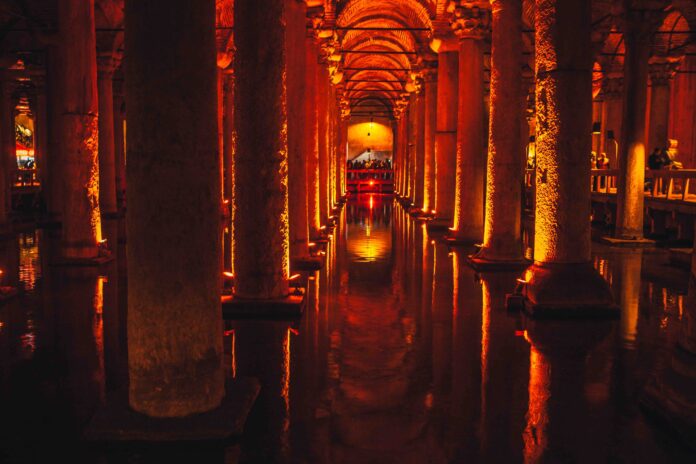The Mysterious Beauty of Istanbul’s Basilica Cistern
Istanbul is undoubtedly one of the most beautiful cities in the world. The metropolis with its rich history, vibrant culture, and breathtaking architecture has been a favorite travel destination for tourists from all over the world for many years.
Among the numerous attractions that Istanbul offers to its visitors, Basilica Cistern (Yerebatan Sarnıcı) is one of the most mysterious and impressive places to visit. At first glance, this subterranean structure might seem like any other underground water cistern.
However, once you step inside the dark chamber beneath Istanbul’s streets where sunlight can’t penetrate, you will be stunned by how grandiose and ornate it is. The Basilica Cistern was built about 1500 years ago during the Byzantine Era and has been a part of Istanbul’s history ever since.
This ancient cistern was built to store potable water for Istanbul’s inhabitants. The cistern was named “Basilica” because it was constructed under an old Roman basilica that no longer exists today.
During its construction under Emperor Justinian I in 532 AD., many columns from various buildings were repurposed by being placed upside down on top of each other as pillars inside the cistern. Today, 336 marble Corinthian-style columns support the roof of this structure which spans approximately 140 metres in length and 70 metres in width making it a true masterpiece of engineering during that period.
As one can imagine with such an impressive historical monument like Basilica Cistern nestled beneath modern-day busy streets , it attracts thousands upon thousands of tourists each year who are curious about this enigmatic site’s past and present significance to Turkey’s capital city . So let’s dive deeper into what makes this underground gem so fascinating!
Step by Step Information of Basilica Cistern
History of Basilica Cistern
Origins of the cistern during the Byzantine era
The Basilica Cistern, also known as Yerebatan Sarnıcı in Turkish, was built during the Byzantine period in Istanbul. It is believed to have been constructed in the 6th century, during the reign of Emperor Justinian I. The cistern was built to provide water for the palace complex located nearby.
It was built underground, and its location was chosen due to its proximity to an aqueduct that brought water from a reservoir outside the city walls. The cistern could hold up to 100,000 tons of water and it was a vital source of water for the city in case of siege or drought.
Construction and purpose of the cistern under Emperor Justinian I
The construction of this massive underground cistern required sophisticated engineering techniques that were ahead of their time. The cistern measures 140 meters by 70 meters and can hold more than 80,000 cubic meters (or about 21 million gallons) of water. The roof is supported by a series of columns that are arranged in rows, forming a grid pattern throughout the space.
There are two types of columns: Doric and Corinthian styles. Some columns were recycled from ancient buildings like temples and have been repurposed for use within this cistern structure.
Historical events that took place at the cistern, including fires and restorations
Throughout history, there have been several incidents involving fire damage or structural issues at Basilica Cistern. During Ottoman times (1453-1922), it played an important role as a source for clean drinking water for Istanbul’s residents but suffered damages due to neglect or malicious intent over time.
In 1985, the cistern underwent a major restoration project, which included cleaning out debris and broken columns, repairing water damage to the walls and installing lights to highlight the structure’s intricate details and design. The restoration efforts have resulted in this magnificent underground structure becoming a popular tourist attraction today.
Architecture and Design Features
The Incredible Size of Basilica Cistern
When you first step inside Basilica Cistern, the sheer size of the space is overwhelming. The cistern measures 140 meters by 70 meters, and it can hold up to 80,000 cubic meters of water.
It’s hard to believe that such a massive structure could have been built over a thousand years ago. The most iconic feature of the cistern is undoubtedly its columns.
There are a total of 336 columns supporting the roof, each one measuring nine meters tall. The columns are arranged in 12 rows of 28 and were likely taken from older structures in Constantinople and repurposed for the cistern.
The Water Sources and Innovative Engineering Techniques
To keep such a massive space filled with water, engineers had to develop innovative techniques to divert water sources from outside the city walls into the cistern. One source was an aqueduct that carried water from about 19 kilometers away into an open-air reservoir near what is now Fatih Mosque.
From there, it flowed through underground channels until it reached Basilica Cistern. One particularly impressive engineering feat is how they managed to fit all those columns into such a large space without them getting in each other’s way.
To solve this problem, they used different column designs that were specifically tailored to their location within the cistern. Some have plain shafts while others have intricate carvings or fluted designs.
The Mystical Atmosphere Inside Basilica Cistern
Visitors often describe a mystical atmosphere inside Basilica Cistern because of its dim lighting and watery reflections on the ceiling. The water in the cistern is about two feet deep (60 cm), which contributes to this unique ambiance as well as making the cistern a popular destination for photographers. Basilica Cistern is an architectural marvel that showcases the incredible engineering skills of its creators.
Its size, columns, and innovative water sources make it a must-visit destination for anyone interested in history and architecture. The mystical atmosphere inside the cistern adds to its charm and makes it an unforgettable experience for tourists visiting Istanbul.
Mythology & Legends Associated with Basilica Cistern
The Basilica Cistern is not only known for its historical significance and architectural beauty, but it also has many fascinating myths and legends associated with it. One of the most interesting stories is about the two Medusa heads that are used as column bases in the cistern.
The Medusa Heads: The story behind two Medusa heads being used as column bases in the cistern.
Legend has it that the two Medusa heads were placed upside down and sideways at the bottom of two columns to negate their powers. In ancient times, people believed that looking into the eyes of Medusa would turn them to stone.
The architects who built Basilica Cistern made sure to place these fearsome creatures in a way that would prevent them from turning anyone who entered the space into statues. According to another legend, Emperor Justinian ordered workers to build a underground temple, where he could meet with his mistress.
However, when he discovered that they had used materials from an ancient temple dedicated to Medusa, he ordered them removed but kept her face as decoration for one of his palaces. Either way, visitors today can still see these fascinating relics from antiquity while wandering through this historic site.
Other myths associated with Basilica Cistern
In addition to the story of Medusa’s head, there are other myths associated with Basilica Cistern. Some say that this was once a palace for a powerful sorcerer who could control water and create magical fountains at will.
Others believe that there is treasure hidden somewhere within its walls. While these stories may not be supported by historical evidence, they add an air of mystery and intrigue to an already fascinating site.
Whether you’re drawn to the Basilica Cistern for its historical significance, its architectural beauty, or its intriguing mythology, there is no denying that this site holds a special place in the hearts of many people who visit it. With so much to see and discover, it’s no wonder that this underground wonder is such a popular destination for tourists visiting Istanbul.
Modern Day Significance
Basilica Cistern is not only a historical landmark, but also an important cultural heritage site that has been preserved and restored over the years. The Turkish government recognized the significance of the cistern and invested in restoration efforts to preserve it as a tourist attraction.
The most recent restoration work took place in 1985 and aimed to restore the water level to its original depth. Today, Basilica Cistern is one of the top tourist attractions in Istanbul, attracting both local and foreign visitors.
Visitors can take guided tours of the cistern, where they can learn more about its history through audio guides or tour guides. The cistern is open every day from 9 am to 6 pm, and tickets are available at the entrance.
Restoration efforts to preserve Basilica Cistern as a cultural heritage site
Over time, Basilica Cistern has faced many challenges that have led to damage and deterioration of its structure. Fires have occurred in the past and resulted in significant damage. Moreover, during Ottoman rule, people used it as a dump for their waste which further degraded its condition.
In response to these challenges, various restoration projects have taken place over time with an aim to restore and maintain this important historical landmark. In recent decades especially there have been several extensive rehabilitation projects done on this wonder of engineering.
How it is currently used for tourism purposes
Today Basilica Cistern serves primarily as a cultural attraction for both tourists and locals alike. There are several ways visitors can experience this remarkable site which stands as testament to Istanbul being capital city throughout centuries.
One popular way is by taking guided tours where you will get an insight into not only its history but also various legends associated with it such as Medusa heads embedded upside down at two columns bases inside this underground world of streams. You can also participate in various musical or cultural events that are held there from time to time.
Overall, Basilica Cistern is a fascinating cultural site with a rich history that visitors can explore and enjoy today thanks to the efforts of the Turkish government and several restoration projects. It is an excellent example of Turkey’s commitment to preserving its heritage for generations to come.
Conclusion
The Basilica Cistern is a fascinating and awe-inspiring historical site that holds great significance for Istanbul’s rich history. For over a millennium, it has stood as a testament to the ingenuity and engineering prowess of Byzantine architects, providing fresh water to the city even during times of crisis. As one of Istanbul’s most popular tourist attractions, it continues to draw visitors from all over the world who are fascinated by its design, mythology, and historical importance.
Throughout its tumultuous history, the Basilica Cistern has endured wars, fires, and natural disasters that have threatened its existence. Despite these challenges, it has been lovingly restored and preserved as a cultural heritage site for future generations to enjoy.
By visiting the cistern today, tourists can appreciate its incredible architecture firsthand while learning about the secrets hidden within its walls. The Basilica Cistern is more than just an ancient structure – it is a living piece of history that continues to enchant and educate people from all walks of life.
As Istanbul grows and changes, this magnificent cistern remains an important reminder of the city’s past. Whether you are interested in architecture or mythology or simply want to soak up some history on your next vacation abroad – be sure not to miss this impressive gem!



